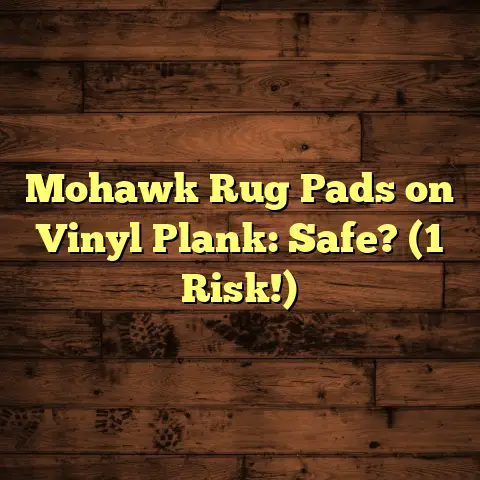Stop Floor Sweating Under Carpets! (1 Fix Needed!)
Did you know that the carpet in your home could be harboring a hidden moisture problem that not only damages your flooring but also poses a risk to your health?
It’s called floor sweating, and it’s more common than you might think. I’ve seen it countless times in my years as a flooring contractor.
It can lead to mold growth, structural damage, and just overall discomfort in your home. Let’s dive in and figure out how to kick this sweaty situation to the curb!
1. Understanding Floor Sweating
So, what exactly is floor sweating?
It’s when moisture condenses on your floor underneath your carpet, making it feel damp or even wet.
Think of it like a cold glass of iced tea on a hot day. The cold glass causes water vapor in the air to condense on its surface.
The same thing happens with your floor when it’s cooler than the air above it. This is especially true in basements or on concrete slabs.
The Science Behind It:
Condensation happens when warm, moist air comes into contact with a cooler surface. The air cools down, and it can’t hold as much moisture anymore.
That extra moisture turns into liquid water on the cooler surface – in this case, your floor.
This is all about temperature differentials!
Common Misconceptions:
A big one is that floor sweating only happens in old houses. Nope! It can happen in new builds, too, especially if they’re not properly insulated or ventilated.
Another misconception is that it’s just a seasonal thing. While it might be worse in humid months, it can be a year-round problem if the underlying issues aren’t addressed.
2. Causes of Floor Sweating
Okay, so what’s causing this unwelcome moisture party under your carpets?
Environmental Factors:
Humidity is a HUGE player. The more moisture in the air, the more likely you are to get condensation.
Temperature fluctuations also play a role. Big swings in temperature can create that perfect environment for condensation to form.
Inadequate ventilation is another culprit. If air can’t circulate properly, moisture gets trapped and has nowhere to go but down into your floor.
Improper Insulation & Building Materials:
Poor insulation can make your floors colder than the air above them, leading to condensation.
Certain building materials, like concrete, are naturally cooler and more porous, making them more prone to sweating.
Real-Life Scenarios:
-
Basement Blues: A homeowner in Ohio calls me because their basement carpet is always damp. Turns out, the basement walls weren’t properly sealed, and moisture was seeping in from the ground, causing the concrete floor to sweat.
-
Summer Slump: A client in Florida complains of musty smells and damp carpets during the summer months. High humidity and inadequate air conditioning were the perfect recipe for floor sweating.
3. The Impact of Floor Sweating
So, why should you care about a little dampness under your carpet? Well, it’s not just a minor inconvenience.
Effects on Different Flooring Types:
-
Hardwood: Water is hardwood’s worst enemy. Floor sweating can lead to warping, cupping, and even rot. I’ve seen beautiful hardwood floors completely ruined by moisture.
-
Laminate: Laminate is more water-resistant than hardwood, but it’s not waterproof. Prolonged exposure to moisture can cause swelling and delamination.
-
Tile: Tile itself is waterproof, but the grout between the tiles isn’t. Moisture can seep through the grout and cause mold growth underneath the tiles.
Health Risks:
Mold and mildew thrive in damp environments. These nasty organisms can release spores into the air, triggering allergies, asthma, and other respiratory problems.
According to the EPA, mold can cause a variety of health issues, from nasal stuffiness and throat irritation to more serious conditions like lung infections. (Source: https://www.epa.gov/mold)
Economic Implications:
Repairing or replacing damaged flooring can be expensive. Mold remediation can also add to the costs.
Plus, a house with a known moisture problem can be harder to sell and may fetch a lower price.
A study by the National Association of Realtors found that moisture problems can decrease a home’s value by as much as 15%.
4. Identifying the Problem
Alright, let’s get practical. How do you know if your floor is sweating under your carpet?
Step-by-Step Assessment:
-
Feel the Carpet: Start by feeling the carpet in different areas, especially along exterior walls and in basements. Does it feel damp or clammy?
-
Sniff Test: Give the carpet a good sniff. A musty or moldy odor is a major red flag.
-
Lift the Carpet: Carefully lift a corner of the carpet and check the padding underneath. Is it damp or discolored?
-
Inspect the Floor: Take a look at the floor itself. Are there any signs of water damage, like discoloration, staining, or warping?
Tips on What to Look For:
-
Dampness: Obviously, dampness is a key indicator.
-
Discoloration: Look for dark spots or stains on the carpet or flooring.
-
Musty Odors: That distinctive musty smell is a telltale sign of mold and mildew.
Simple Moisture Test:
You can buy a simple moisture meter at most hardware stores. These devices measure the moisture content of wood, concrete, and other materials.
A reading above a certain level (usually around 17% for wood) indicates a moisture problem.
Document Your Findings:
Take photos of any areas of concern. Write down where you found dampness, discoloration, or odors.
This documentation will be helpful if you decide to call in a professional.
5. The One Fix You Need: Moisture Barrier Underlayment
Okay, we’ve identified the problem. Now, let’s talk about the solution.
In my experience, the single most effective fix for floor sweating under carpets is installing a high-quality moisture barrier underlayment.
How it Works:
A moisture barrier underlayment is a thin layer of material that sits between your subfloor and your carpet. It’s designed to prevent moisture from rising up from the subfloor and getting trapped under the carpet.
Think of it as a raincoat for your floor!
The Technology & Materials:
Most moisture barrier underlayments are made from polyethylene or polypropylene. These materials are waterproof and resistant to mold and mildew.
Some underlayments also have a built-in vapor barrier to further prevent moisture from passing through.
Reputable Products & Services:
-
DMX Airflow: This is a dimpled underlayment that creates an air gap between the concrete and the flooring. This allows for airflow and evaporation, preventing moisture buildup. I’ve used this product on countless basement floors with great success.
-
DRIcore Subfloor: These are interlocking subfloor panels with a built-in moisture barrier. They’re a great option for basements because they also provide insulation and a more comfortable walking surface.
-
Roberts Black Jack: This is a waterproof adhesive that can be used to seal seams in your underlayment. It’s a good idea to use this to create a continuous moisture barrier.
6. Implementation: Installing the Moisture Barrier
Alright, let’s get down to the nitty-gritty. How do you actually install this moisture barrier underlayment?
DIY or Professional?
This is a decision you’ll need to make based on your skill level and the size of the project.
If you’re comfortable with basic DIY tasks and the area is relatively small, you can probably handle it yourself.
However, if you’re dealing with a large area or you’re not confident in your abilities, it’s best to call in a professional.
Tools & Materials:
- Moisture barrier underlayment
- Utility knife
- Measuring tape
- Seam tape (if needed)
- Knee pads (trust me, you’ll want these!)
- Broom or vacuum
Step-by-Step Guide:
-
Prepare the Subfloor: Make sure the subfloor is clean, dry, and free of debris. Sweep or vacuum thoroughly.
-
Measure & Cut: Measure the area where you’ll be installing the underlayment. Cut the underlayment to size using a utility knife.
-
Lay the Underlayment: Roll out the underlayment and position it in place. Make sure it’s flat and smooth.
-
Seal the Seams: If you’re using multiple pieces of underlayment, seal the seams with seam tape to create a continuous moisture barrier.
-
Install Carpet: Install your carpet over the underlayment according to the manufacturer’s instructions.
Choosing the Right Contractor:
If you decide to hire a professional, here are a few things to look for:
-
Experience: Choose a contractor with experience installing moisture barrier underlayments.
-
Reputation: Check online reviews and ask for references.
-
Insurance: Make sure the contractor is licensed and insured.
-
Warranty: Ask about the contractor’s warranty on their work.
7. Maintenance and Prevention
Okay, you’ve installed your moisture barrier underlayment. Now, how do you make sure floor sweating doesn’t come back?
Ongoing Maintenance Tips:
-
Regularly Vacuum: Vacuum your carpets regularly to remove dust, dirt, and other debris that can trap moisture.
-
Clean Spills Immediately: Wipe up any spills as soon as they happen to prevent them from soaking into the carpet and subfloor.
-
Check for Leaks: Regularly inspect your plumbing for leaks. Even a small leak can cause moisture problems.
Preventive Measures:
-
Improve Ventilation: Make sure your home is properly ventilated. Open windows and doors when the weather allows. Use exhaust fans in bathrooms and kitchens.
-
Use a Dehumidifier: If you live in a humid climate, consider using a dehumidifier to reduce the moisture content of the air. The ideal humidity level is between 30% and 50%.
-
Proper Insulation: Make sure your home is properly insulated to prevent temperature fluctuations and condensation.
Adjustments in Your Home Environment:
-
Avoid Overwatering Plants: Overwatering indoor plants can increase humidity levels.
-
Dry Clothes Outdoors: Avoid drying clothes indoors, as this can also increase humidity.
-
Use a Vapor Barrier in Crawl Spaces: If you have a crawl space, make sure it has a vapor barrier to prevent moisture from seeping into your home.
8. Real-Life Success Stories
I’ve seen firsthand how effective a moisture barrier underlayment can be in solving floor sweating problems.
Testimonial 1:
“I had a terrible mold problem in my basement. I tried everything, but nothing seemed to work. Then I installed DMX Airflow underlayment, and it completely solved the problem. My basement is now dry and mold-free!” – Sarah J., Columbus, OH
Testimonial 2:
“I was constantly battling damp carpets in my Florida home. After installing a moisture barrier underlayment, my carpets are now dry and comfortable. I highly recommend this solution!” – Tom B., Miami, FL
Transformative Effects:
Solving a floor sweating problem can have a huge impact on your home and your health. It can eliminate musty odors, prevent mold growth, and create a more comfortable living environment.
Plus, it can protect your investment in your flooring and prevent costly repairs down the road.
Conclusion
Floor sweating under carpets is a common problem, but it’s one that you can solve.
By installing a high-quality moisture barrier underlayment and taking steps to prevent moisture buildup, you can create a dry, healthy, and comfortable home.
Don’t let floor sweating ruin your flooring and your health. Take action today and enjoy the long-term benefits of a dry and happy home!
Remember, a little prevention goes a long way. By addressing the root causes of floor sweating and taking proactive steps to manage moisture, you can protect your home and your health for years to come.





